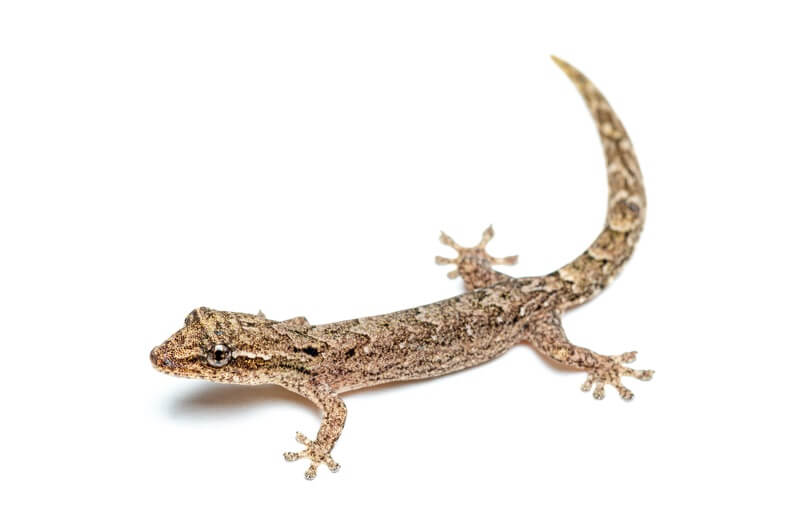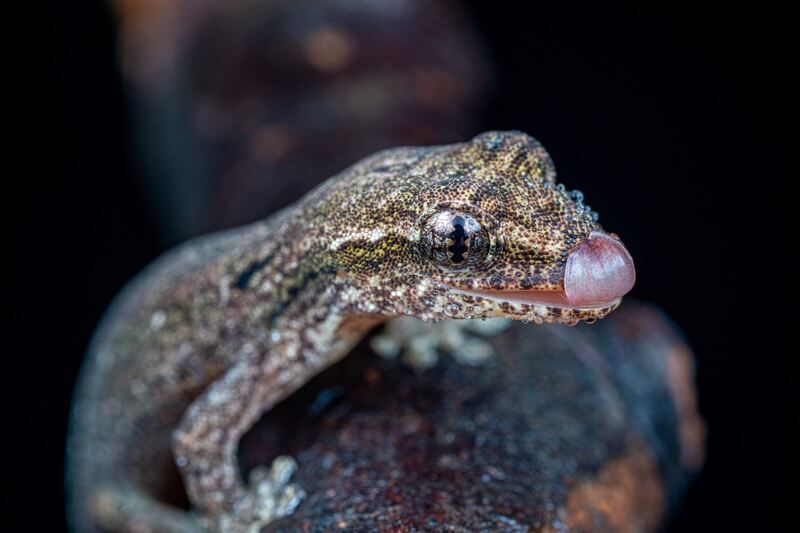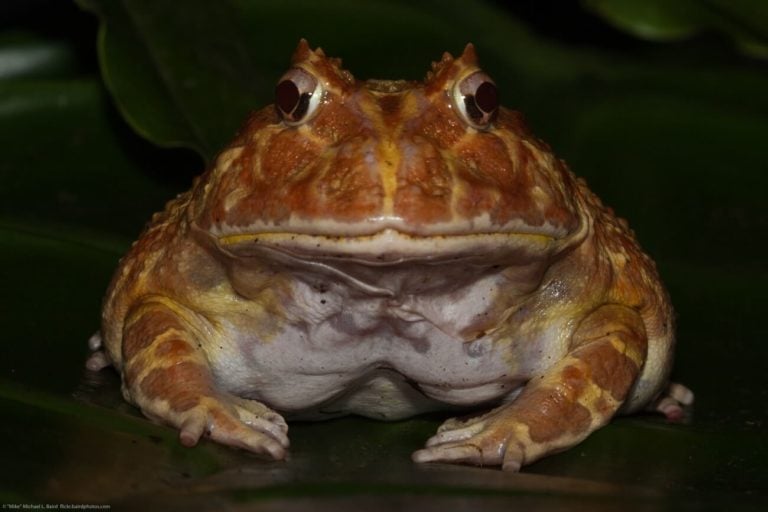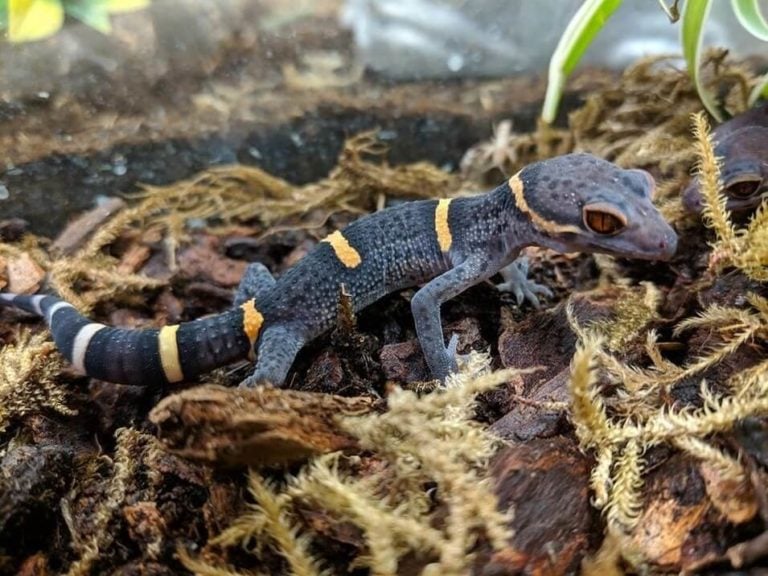Mourning geckos are a fascinating species that are extremely unique. On top of that, they’re a pleasure to own and quite fun to watch!
This guide will cover everything you need to know about mourning gecko care. We’ll go over their diet, size, reproductive process, handling tips, and more.
Table of Contents
Species Summary
The mourning gecko (Lepidodactylus lugubris) is a fascinating reptile species with a unique defining trait. These lizards are parthenogenetic, which means that the females reproduce asexually without males. It’s an exciting process that results in tiny little clones!
Expert Tip: Because reproduction only requires egg-laying, a vast majority of mourning geckos are females. Males do exist, but they’re rare and usually infertile.
This species is quite prevalent in coastal areas surrounding the Pacific and Indian oceans. From the Maldives to the Galapagos Islands, mourning geckos are widespread. They’re also a favorite in the herpetology community.
Thanks to their peaceful demeanor, penchant for quick reproduction, and easy-going nature, mourning gecko care is rather simple. They’re a captivating species that caters to both novice and seasoned reptile owners.
Appearance & Colors
Like many species in the Gekkonidae family, mourning geckos like to stay out of sight in the wild. They’re cryptically colored to blend into their surroundings.

Most of the body is dark to light tan. Dark brown or black markings adorn the back.
Another exciting thing about these lizards is that they can modify their color. Firing up or down allows them to adjust to their surroundings. As a result, the same gecko may appear lighter or darker at different times during the day.
Expert Tip: Beyond the coloration, mourning geckos have all the hallmark features you’d expect from geckos. That includes a triangular head, a prominent tail, and sticky pads on their feet.
Average Mourning Gecko Size
These reptiles are on the smaller end of the size spectrum. The average mourning gecko size is usually between three and four inches when fully grown.
Upon hatching, juveniles are a mere 1.5 inches long!
Thanks to their small size, mourning geckos are great for those with limited space. They don’t need a very large enclosure in order to thrive (more on that later).
Lifespan
The average mourning gecko lifespan is roughly ten years with proper care. They can live up to 15 years, but those instances are few and far between.
Of course, there are no guarantees when it comes to lifespan. Many factors can contribute to their longevity. The quality of care you provide is one of the biggest.
Providing a pristine habitat, a nutrient-rich diet, and good general husbandry can help your mourning gecko avoid disease and early death.
Mourning Gecko Care
Mourning gecko care is relatively easy compared to other species. Undemanding and adaptable, these pet lizards are pretty forgiving and don’t require precise environmental conditions to thrive.
That said, this type of gecko does have some distinct needs to fulfill and unique challenges to overcome. Here are some critical care guidelines you need to follow when caring for a mourning gecko.
Enclosure Size
The first thing to do is create a suitable enclosure. Thanks to their small size, mourning geckos can live happily in a compact five-gallon terrarium.
However, most herpetology enthusiasts would agree that a moderately sized enclosure is best. Social creatures by nature, mourning geckos live better in small groups of five or six.
To accommodate a community of that size, you’ll need an enclosure that’s at least 12 inches long, 12 inches wide, and about 18 inches tall. A standard aquarium tank will do. However, many enthusiasts prefer to use a terrarium with front-facing doors and adjustable ventilation slots.
Expert Tip: Whatever you use, make sure that the enclosure is secure with a tight-fitting lid or door. Mourning geckos are notorious escape artists, so you must ensure that there’s no way to wriggle out.
Habitat Setup
Creating a habitat setup that mimics their natural environment is an incredibly important part of mourning gecko care. A lush environment with plenty of climbing surfaces will provide all the enrichment they need to stay happy.
Start with a layer of an absorbent substrate. Coconut coir, sphagnum moss, and even reptile-safe soil will work. The latter choice is ideal if you plan on using live plants.

Add a slew of live or artificial plants around the enclosure. Vegetation provides coverage while giving the gecko ways to climb. Mix things up with leafy bushes, climbing vines, and canopy-style shade plants.
Lastly, install several cork branches and climbing platforms. It’s best to create a network of multiple climbing paths.
Temperature & Lighting
Mourning geckos prefer daytime temperatures between 70 and 80 degrees Fahrenheit. Temperatures can fall as low as 65 degrees at night, but if it dips more than that regularly, you’ll need to invest in a heat emitter to keep your gecko comfortable.
Creating a slightly hotter basking spot is important as well. Mourning geckos thermoregulate by moving to different areas in the enclosure. A temperature gradient allows them to find just the right body temperature.
On a tall climbing spot, use a basking lamp to raise the temperature to 85 degrees. It’s a good idea to invest in a thermometer to ensure that your gradient is stable and consistent.
Expert Tip: The jury is still out about whether or not UV light is necessary. Some think it’s a must while others don’t. Contrary to popular belief, mourning geckos are cathemeral and not entirely nocturnal.
For this reason, many choose to install a UV light on a timer to be on the safe side.
Humidity
Providing a high level of humidity is an essential part of mourning gecko care. This species needs at least 50 percent humidity at all times to avoid complications. For the best results, aim for 60 to 70 percent.
It’s always a good idea to invest in a hygrometer. To maintain relative humidity levels, mist the enclosure daily or install an automatic mister.
Water
Mourning geckos rarely drink from standing water. Most stay hydrated by lapping up droplets from plant leaves.
However, providing a small water dish is still paramount. The lizard can use the container to cool off or soak.
Use a shallow dish that’s large enough for your pet to crawl inside. Monitor the bowl and replenish the water supply regularly. It’s not uncommon for mourning geckos to defecate in the bowl, so you’ll need to clean it often to avoid bacterial issues.
Food & Diet
In the wild, mourning geckos consume a wide variety of foods. They’re natural omnivores that require both high-protein meals and plant-based foods.
A healthy mix of insects and commercial gecko food is best. For protein, you can provide pinhead crickets, fruit flies, Calci-worms, and tiny roaches. As always, make sure to gut-load the insects to avoid disease.
It’s a good idea to dust them with calcium and Vitamin D3 supplement powders a few times a week, too.
For plant-based foods, many mourning gecko owners like to feed nectar-based commercial foods or mashed fruit.
Expert Tip: An important thing to remember when it comes to mourning gecko care is that these reptiles need to eat most days of the week. Generally, the go-to diet plan is plant-based foods twice a week and protein-based foods three times a week. For the remaining two days, fast the lizards for healthy digestion.
Potential Health Issues
Mourning geckos are at risk of suffering from all the usual health issues that pet reptiles face.
The most common ailments to be wary of include:
- Respiratory infections
- Bacterial infections
- Skeletal issues.
Respiratory infections are a result of poor environmental conditions. Improper temperature settings and wrong humidity levels are the main culprits. Infections can lead to inflammation of mouth and throat tissue, which eventually results in discharge and pain.
Bacterial issues can wreak havoc on your lizard’s health. It can get into cuts or scratches, cause disease, and more.
To avoid bacteria problems, clean the enclosure regularly. Spot clean messes as they occur. Then, perform a deep clean every four weeks or so. During those intense cleaning sessions, you must take out every item and apply reptile-safe sanitizers to keep bacteria at bay.
Finally, there are skeletal issues. Conditions like metabolic bone disease occur when reptiles don’t get enough calcium in their system. The bones become fragile and prone to breakage.
Implement calcium supplements into your gecko’s diet to keep their bones healthy and strong.
Behavior & Temperament
For the most part, mourning geckos are pretty peaceful. They’re friendly creatures and do best in large social groups. Some herpetology lovers even house them with other reptile species like poison dart frogs.
You can keep mourning geckos on their own. However, solitary lizards tend to remain shy and spend most of their time in hiding.
To truly enjoy the mourning gecko’s personality, it’s best to keep them in small communities. When kept with others, these lizards become vocal and playful. You may hear them making squeaks and creaks as they communicate.
As mentioned earlier, mourning geckos are cathemeral. They have irregular patterns of behavior throughout the day. However, most tend to be active at night.
Expert Tip: Because most geckos are female, territorial behaviors aren’t an issue. Occasional infighting and aggression are typical. However, sparring rarely results in serious injury.
One thing you will have to pay attention to is egg-laying. Mourning geckos reach sexual maturity at about eight months of age. At that point, they’ll start to lay about two eggs every four to six weeks.
Males aren’t part of the reproductive process, so juvenile geckos can emerge from the eggs in as little as two months.
Handling Them
Despite being the perfect size to fit into your palm, mourning geckos don’t do well with physical handling. They’ll tolerate brief touch as you move them from one enclosure to another during cleaning sessions. But prolonged handling isn’t a good idea.
These lizards are quick and highly cunning. They’re always looking for a chance to escape. Because they’re so small, it’s easy to lose grip as they try to leap out of your hand.
It’s best to minimize handling as much as possible and only enjoy these lizards through observation.
Closing Thoughts
As long as you understand the basic needs of these reptiles, mourning gecko care is quite simple. That’s just one of the reasons why these lizards are one of our favorites, and we recommend them all the time.
Let us know if you have any questions about this species. We’re always happy to help.



